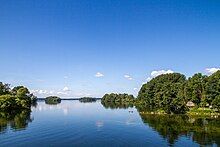Islands in the Großer Plöner See and the Störland peninsula
Coordinates: 54 ° 7 ′ 55 ″ N , 10 ° 23 ′ 54 ″ E
Islands in the Großer Plöner See and the Störland peninsula is a nature reserve in the Schleswig-Holstein city of Plön and the municipality of Nehmten in the Plön district .
The approximately 261 hectare nature reserve is registered under number 103 in the directory of nature reserves of the Ministry for Energy Transition, Agriculture, Environment and Rural Areas. It was expelled in 1992 (date of regulation: November 25, 1992). The responsible lower nature conservation authority is the district of Plön. The nature reserve is part of the FFH area “Lakes of the Middle Schwentine System and Surroundings” and the EU bird protection area “Großer Plöner See-Area”. South and west it borders on the landscape protection area "Nehmtener forestry and Nehmtener shores of Great Plön Lake". The nature reserve is looked after by the Schleswig-Holstein State Association of the Nature Conservation Union of Germany .
The nature reserve is located southwest of Plön in the Holstein Switzerland Nature Park . It protects the central shallow water zone of the Großer Plöner See with the islands of Alswarder, Kronau, Ziegen Warder, Sack, Triebs, Langes Warder and Rotten Warder as well as the peninsula Störland and the Seebrook. It is an important breeding and resting area for various water birds .
Near-natural woody stands grow on the islands of the nature reserve. They are of various ducks and geese used as breeding grounds and provide their tree holes also Goldeneye and Goosander suitable breeding sites. The white-tailed eagle also breeds here. Reed areas offer Marsh Harriers and Reed Warblers a suitable habitat. However, the population of reed dwellers is declining due to the decline in reeds that has persisted for years . The shallow water zones of the nature reserve and the islands are also frequented by large flocks of ducks, geese and divers during the moult . During bird migration , the area is an important resting and wintering area. So here u. a. Herons and Common Goldeneye, Great Crested Grebe , Gray Goose , Little Gull and coot in great number.
The Störland peninsula in the south of the nature reserve and the Seebrook are characterized by wet grassland areas with rush swamps, which are structured by hedges . The grassland areas are grazed extensively with Galloways . Here are u. a. Red-backed shrike and nightingale and plants such as nodding thistle , granite saxifrage , coltsfoot and heather can be found. By stopping the drainage of the meadows , natural depressions were rewetted . The banks of the Großer Plöner See are occupied by alder forests.
At the southern edge of the nature reserve there is a redder from which parts of the nature reserve can be viewed. To the south, agricultural areas , which are also divided by hedges, connect to the nature reserve.
Web links
- El Dorado for geese and eagles - NSG islands in the Großer Plöner See and Störland peninsula , NABU Schleswig-Holstein
- Islands in the Great Lake Plön and the Störland peninsula , leaflet from the State Office for Nature and the Environment of Schleswig-Holstein (PDF, 882 kB)
Individual evidence
- ↑ State ordinance on the nature reserve "Islands in the Great Plön Lake and the Störland Peninsula" of November 25, 1992 , state regulations and state case law, state government Schleswig-Holstein. Retrieved February 18, 2016.
- ^ Lakes of the middle Schwentine system and the surrounding area , profiles of the Natura 2000 areas, Federal Agency for Nature Conservation . Retrieved March 12, 2020.
- ↑ Large Plöner See area , profiles of the Natura 2000 areas, Federal Agency for Nature Conservation. Retrieved March 12, 2020.
- ^ Supervision of protected areas in Schleswig-Holstein , State Office for Agriculture, Environment and Rural Areas (PDF, 275 kB). Retrieved April 20, 2018.
- ↑ Nachtigall , Ornithological Working Group for Schleswig-Holstein and Hamburg (PDF file, 224 kB). Retrieved February 18, 2016.
- ↑ Islands in the Great Plöner See and the Störland peninsula , Holstein Switzerland Nature Park. Retrieved February 18, 2016.



